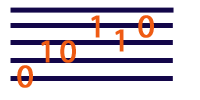WARNING - This tutorial describes the old original JSyn API. Please refer to the current docs for more up-to-date information.
JSyn Tutorial
Generating Other Waveforms from the Sawtooth
Let's take another look "under the hood" and see how JSyn generates some of the other waveforms. It turns out that the sawtooth wave is the starting point for generating all the other waveforms.Remember, you won't have to use these techniques in your programs. You just create a SquareOscillator, or some other oscillator, and use it. But this page will give you a better understanding of what you are getting.
Here we can see
a square wave in red superimposed over a sawtooth wave. Notice that when
the sawtooth wave is above zero that the square is high, and vice versa.
So to make a square wave, JSyn first generates a sawtooth then does this:
if( saw > 0.0 ) square = 1.0; else square = -1.0;
if( saw >= 0.0 ) triangle = 1.0 - ( 2.0 * saw ); else triangle = 1.0 + ( 2.0 * saw );
sineWave = sin( PI * saw );
